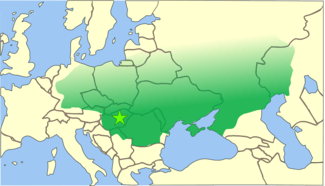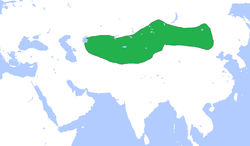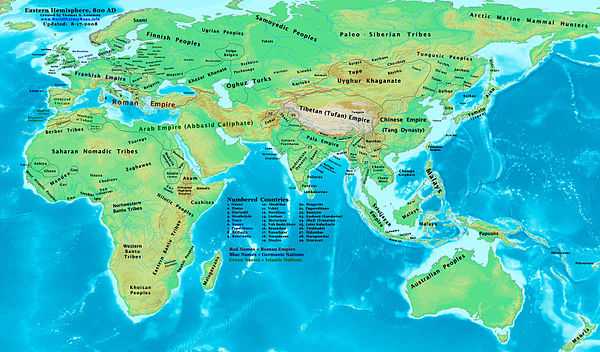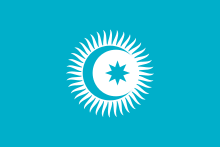Nomadic empire
Nomadic empires, sometimes also called steppe empires, Central or Inner Asian empires, are the empires erected by the bow-wielding, horse-riding, nomadic peoples in the Eurasian steppe, from classical antiquity (Scythia) to the early modern era (Dzungars).
Nomadic empires typically operated by establishing a capital city inside a conquered sedentary state, and then by exploiting the existing bureaucrats and commercial resources of that non-nomadic society. As the pattern is repeated, the originally nomadic dynasty becomes culturally assimilated to the culture of the occupied nation before its ultimate overthrow.[1] Ibn Khaldun described a similar cycle on a smaller scale in his Asabiyyah theory. A term used for these polities in the early medieval period is khanate (after khan, the title of their rulers), and after the Mongol conquests also as orda (horde) as in Golden Horde.
Antiquity
Cimmeria
The Cimmerians were an ancient Indo-European people living north of the Caucasus and the Sea of Azov as early as 1300 BCE until they were driven southward by the Scythians into Anatolia during the 8th century BC. Linguistically they are usually regarded as Iranian, or possibly Thracian with an Iranian ruling class.
- The Pontic-Caspian steppe: southern Russia and Ukraine until 7th century BCE.
- The northern Caucasus area, including Georgia and modern day Azerbaijan
- Central, East and North Anatolia 714-626 BCE.
Scythia
The Scythians dominated the Eurasian steppe from the 8th century BCE to the 2nd century CE. The area known to classical authors as Scythia included:
- The Pontic-Caspian steppe: Kazakhstan, southern Russia and Ukraine (inhabited by Scythians from at least the 8th century BCE)
- The northern Caucasus area, including Georgia and modern day Azerbaijan
- Sarmatia, corresponding to the modern Ukraine and parts of Belarus and Poland[2] 5th century BCE to 4th century CE
- Scythia Minor, corresponding to the southern Ukraine with the lower Danube river area and a part of modern Romania
The Sakas (Indo-Scythians) also expanded to Sistan and the Indus valley in the 1st century BCE.
Xiongnu

The Xiongnu were a confederation of nomadic tribes from Central Asia with a ruling class of unknown origin and other subjugated tribes. They lived on the Mongolian Plateau between the 3rd century and the 460s, their territories including modern day Mongolia, southern Siberia, western Manchuria, and the modern Chinese provinces of Inner Mongolia, Gansu, and Xinjiang. The Xiongnu was the first empire of nomadic peoples. Relations between early Chinese dynasties and the Xiongnu were complicated and included military conflict, exchanges of tribute and trade, and marriage treaties. They were considered so dangerous and disruptive that the Qin Dynasty ordered the construction of the Great Wall to protect China from Xiongnu attacks.
Hunnic Empire

The Huns were a confederation of Eurasian tribes from the Steppes of Central Asia. Appearing from beyond the Volga River some years after the middle of the 4th century, they conquered all of eastern Europe, ending up at the border of the Roman Empire in the south, and advancing far into modern day Germany in the north. Their appearance in Europe brought with it great ethnic and political upheaval and may have stimulated the Great Migration. The empire reached its largest size under Attila between 447 and 453.
Mongolic people and Turkic expansion
Rouran

The Rouran (柔然), Juan Juan (蠕蠕), or Ruru (茹茹) were a confederation of Mongolic speaking[3] nomadic tribes on the northern borders of China from the late 4th century until the late 6th century. They controlled the area of Mongolia from the Manchurian border to Turpan and, perhaps, the east coast of Lake Balkhash, and from the Orkhon River to China Proper.
Göktürks

The Göktürks or Kök-Türks were a Turkic people of ancient North and Central Asia and northwestern China. Under the leadership of Bumin Khan and his sons they established the first known Turkic state around 546, taking the place of the earlier Xiongnu as the main power in the region. They were the first Turkic tribe to use the name "Türk" as a political name. The empire was split into a western and an eastern part around 600, merged again 680, and finally declined after 734.
Uyghurs

The Uyghur Empire was a Turkic empire that existed in present day Mongolia and surrounding areas for about a century between the mid 8th and 9th centuries. It was a tribal confederation under the Orkhon Uyghur nobility. It was established by Özmish Khan in 744, taking advantage of the power vacuum in the region after the fall of the Gökturk Empire. It collapsed after a Kyrgyz invasion in 840.
Middle Ages
Mongol Empire

The Mongol Empire was the largest contiguous land empire in history at its peak, with an estimated population of over 100 million people. The Mongol Empire was founded by Genghis Khan in 1206, and at its height, it encompassed the majority of the territories from southeast Asia to eastern Europe.
After unifying the Mongol–Turkic tribes, the Empire expanded through conquests throughout continental Eurasia. During its existence, the Pax Mongolica facilitated cultural exchange and trade on the Silk Route between the East, West, and the Middle East in the period of the 13th and 14th centuries. It had significantly eased communication and commerce across Asia during its height.[4][5]
After the death of Möngke Khan in 1259, the empire split into four parts (Yuan Dynasty, Il-Khans, Chagatai Khanate and Golden Horde), each of which was ruled by its own Khan, though the Yuan rulers had nominal title of Khagan. After the disintegration of the western khanates and the fall of the Yuan Dynasty in China in 1368, the empire finally broke up.
Timurid Empire

The Timurids, self-designated Gurkānī, were a Turko-Mongol dynasty, established by the warlord Timur in 1370 and lasting until 1506. At its zenith, the Timurid Empire included the whole of Central Asia, Iran and modern Afghanistan, as well as large parts of Mesopotamia and the Caucasus.
Dzungars
The Dzungars were a confederation of several Oirat tribes who formed and maintained the last horse archer empire from the early 17th century to the middle 18th century. They emerged in the early 17th century to fight the Altan Khan of the Khalkha, the Jasaghtu Khan and their Manchu patrons for dominion and control over the Mongolian people and territories. In 1756 this last nomadic power was dissolved due to the Oirat princes' succession struggle and costly war with the Qing Dynasty.
Further reading
- Amitai, Reuven; Biran, Michal (editors). Mongols, Turks, and others: Eurasian nomads and the sedentary world (Brill's Inner Asian Library, 11). Leiden: Brill, 2005 (ISBN 90-04-14096-4).
- Drews, Robert. Early riders: The beginnings of mounted warfare in Asia and Europe. N.Y.: Routledge, 2004 (ISBN 0-415-32624-9).
- Grousset, Rene. The Empire of the Steppes: a History of Central Asia, Naomi Walford, (tr.), New Brunswick, NJ: Rutgers University Press, 1970.
- Hildinger, Erik. Warriors of the steppe: A military history of Central Asia, 500 B.C. to A.D. 1700. New York: Sarpedon Publishers, 1997 (hardcover, ISBN 1-885119-43-7); Cambridge, MA: Da Capo Press, 2001 (paperback, ISBN 0-306-81065-4).
- Kradin, Nikolay. Nomadic Empires: Origins, Rise, Decline. In Nomadic Pathways in Social Evolution. Ed. by N.N. Kradin, Dmitri Bondarenko, and T. Barfield (p. 73-87). Moscow: Center for Civilizational Studies, Russian Academy of Sciences, 2003.
- Kradin, Nikolay. Nomads of Inner Asia in Transition. Moscow: URSS, 2014 (ISBN 978-5-396-00632-4).
See also
- List of Mongol states
- Mongol and Tatar states in Europe
- List of Turkic dynasties and countries
- Eurasian nomads
- History of Central Asia
- Military history of Asia
- Historic states represented in Turkish presidential seal
References
- ↑ Golden, Peter B. (1992). An Introduction to the History of the Turkic Peoples: Ethnogenesis and State Formation in the Medieval and Early Modern Eurasia and the Middle East. Southgate Publishers. p. 75.
- ↑ Harry Thurston Peck, Harpers Dictionary of Classical Antiquities (1898) Oceanus Sarmaticus
- ↑ William Montgomery McGovern - early empires of Central Asia ,p. 421
- ↑ Gregory G.Guzman - the barbarians a negative or positive factor in ancient and medieval history?, The historian 50 (1988), 568-70
- ↑ Thomas T.Allsen - and conquest in Mongol Eurasia, 211
